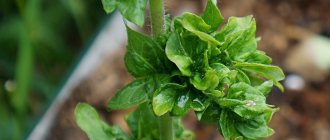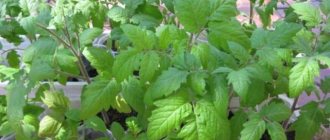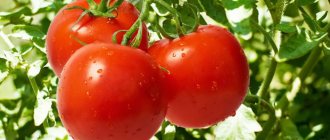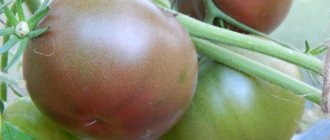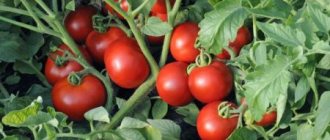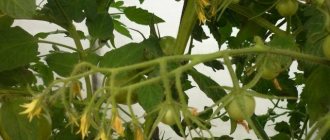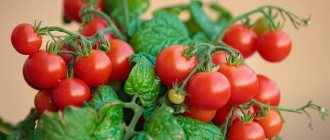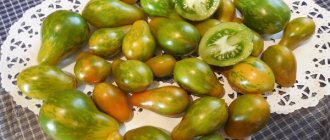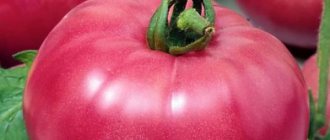Experienced gardeners are familiar with Rocket tomatoes. This variety is characterized in a number of areas as hardy, capable of producing crops in any summer, even if the weather is cold.
| Height | Landing location | Ripening time | Fruit color | Fruit size | Origin | Fruit shape |
| short | Open ground | Mid-early | Reds | Small | Variety | Plum-shaped or oval |
History of the variety's creation
This tomato was bred at the end of the third quarter of the last century by breeders from the city of Krymsk. This tomato was included in the State Register in 1975, but only 5 years later the variety was included in this register.
We also recommend
Tomato Finish
However, the recommendations for places where the variety was grown were unexpected: North Caucasus, Central Black Earth, West Siberian and Ural regions. But it was not entirely clear why, among the proposed places for growing tomatoes, the North Caucasus with its warm climate and the Urals with unpredictable weather conditions and a short summer season are adjacent.
Related article:
Tomato Bull's Heart - description and characteristics of a high-yielding variety
Vegetable growers read the description of the variety and decided in their own way - they began to grow the Raketa tomato everywhere in Russia, both in garden beds and in greenhouse conditions.
Features of caring for the variety
To achieve high yields, you will have to work hard. The variety needs:
- moderate watering;
- periodic feeding;
- Preventive treatments against rot and pests.
See also: Features of growing cherry tomatoes on a windowsill
Minimal care and favorable weather allow you to grow a luxurious harvest.
Watering and loosening the soil
The Rocket tomato is afraid of severe waterlogging of the soil and often suffers from rot in rainy years. Plants are watered moderately, trying to avoid stagnation of moisture. The number of waterings per season depends on weather conditions.
After watering, loosening the soil is necessary. This procedure will prevent the formation of a dense crust on the surface and provide free access to oxygen.
Top dressing
After transplanting the Rocket variety to a permanent place, feeding is not carried out for at least the first two weeks. In the future, for the timely development and ripening of fruits, plants need fertilizers. Complex fertilizers with potassium, phosphorus, magnesium and boron are used as fertilizers. Treatment is carried out twice with a difference of two weeks.
Pinching and tying
The Rocket tomato is characterized by low growth. Its shoots grow no more than 60 cm. The variety does not require pinching.
Expert opinion
Stanislav Pavlovich
Gardener with 17 years of experience and our expert
Ask a Question
Important! To ensure good ventilation and prevent the development of rot, it is recommended to cut off the lower foliage and shoots. However, you shouldn’t get carried away with this in the early stages. Excessive removal of foliage will delay the formation of ovaries on plants.
The variety has strong stems and most often does not need staking. However, if the branches are heavily overloaded with ripening fruits, tying them to supports will prevent damage to the branches.
Description of the variety
Tomato seeds Rocket “Aelita”
This tomato variety is classified as a mid-early tomato; usually the harvest begins 120 days after germination of the seed material. The bushes themselves are of a determinate type, so they do not grow tall - the height of their shoots is about 0.5 m, and their width is not too large, which allows you to plant more bushes of this variety on each square of area.
Take a closer look at the Chelyabinsk meteorite tomato
The bushes do not require formation; few stepsons are formed. Also, tying up the shoots is not required, only if there are too many fruits on the bushes, then it is worth tying the stems to strong supports.
Related article:
What tomatoes need in August-September
The shoots are not too densely leafy, so the ripening fruits will be well illuminated by the sun's rays. The foliage is medium wide and quite long, shiny, rich emerald color.
Tomato Rocket
The flowers are small, yellow, collected in racemose inflorescences, each inflorescence can form up to 6 ovaries. The first brush is formed under the 6th or 7th true leaf, and each subsequent brush forms after a couple of leaves.
Growing different varieties of tomatoes
Ripe tomatoes have an elongated plum-shaped shape with smooth, even skin. It is quite compacted, rich red in color, and not prone to cracking. The fruits are small in size, weighing about 40-55 g. The taste of ripe fruits is not considered too pleasant; the fruits contain a fairly large amount of acid, so their tasting score is about 4 points out of 4 possible.
Related article:
Sowing tomatoes for seedlings
The pulp in the fruit is fleshy, quite juicy, and can contain up to 3 seed chambers with an average content of seed material.
Ripe tomatoes, after full ripening, can hang on the bushes for quite a long time without over-ripening. The harvest ripens smoothly, it can be harvested mechanized, which is very convenient when growing Rocket tomatoes on an industrial scale.
Tomato Rocket
The harvested crop can be transported to different distances; under appropriate storage conditions, the fruits can retain their beautiful appearance and quite pleasant taste for a long time.
Harvesting and application
Once the tomatoes turn bright red or yellow (depending on the variety), they can be harvested. As a rule, ripening occurs in July. You need to pick tomatoes carefully so as not to damage either the branches or the tomato itself. For storage, you can put the fruits in a box lined with newspaper. There is no need to put too many tomatoes in one box, as the fruits lying below may become wrinkled.
The box should be stored in a dry place, but not in direct sunlight. The room temperature should not exceed +6 degrees, otherwise the tomatoes may begin to deteriorate.
If there is a need for long-term storage of tomatoes (more than 3 weeks), they should be removed from the branches slightly unripe and placed in boxes to ripen in the same way.
The use of the crop can be very diverse: the fruits of the described variety are very convenient to preserve, they fit perfectly into jars.
Rocket tomatoes will decorate your holiday table even in the form of regular cuts (especially if you alternate yellow and red fruits).
We also shouldn’t forget about the beneficial properties of tomatoes: tomatoes are a powerful antioxidant. Lycopene, which is part of the tomato, helps in the treatment of many diseases.
In addition, tomatoes have an antibacterial effect. Tomatoes can also fight blood clots, and due to the serotonin they contain, they improve your mood.
Productivity
Despite the fact that the bushes of this variety do not grow tall, the yield of the Raketa tomato is quite high for a determinate plant: when grown on an industrial scale, up to 590 centners of ripe fruit can be harvested by mechanization from each hectare. After such assembly, single fruits remain on the shoots, which gradually ripen.
Related article:
Tomato Snow Tale - description and characteristics of an early variety
Rocket tomatoes in cross section
When grown on private plots, up to 6.5 kg of tomatoes are harvested from each square of area. Moreover, when grown in greenhouse conditions, the tomato yield may be slightly higher.
Growing
The classic way to grow Rocket tomatoes is by planting them in open ground. In those regions where the total amount of heat is not enough to ripen tomatoes, seedlings are placed in polycarbonate or glass greenhouses. In the middle zone there are enough greenhouses with a film coating, which can be removed during the hot period.
Over the years of cultivation, the variety has received positive reviews, which also contain advice on agricultural technology:
- Despite the density of the foliage, you should not pick it off, as this procedure will delay the formation of fruits.
- When watering, it is necessary to leave the leaves dry, as wet shoots can get sunburn, which is often confused with late blight.
- The soil at the roots of plants cannot be kept constantly damp, despite the fact that the Rocket variety is a moisture-loving tomato; an excess of water can cause cracking of the fruits and rotting of the roots.
- When growing tomatoes recommended for open ground, it is necessary to take into account that tomatoes are still not resistant to night frosts and can die from hypothermia if planted early.
Planting seeds
Before planting tomato seedlings, you should prepare the soil mixture. For planting, both ready-made soil from the store and prepared with your own hands are suitable. To do this, it is necessary to combine ordinary soil and humus in equal parts 2 weeks before sowing, and then subject it to heat treatment by placing it in the oven for 10-15 minutes or pouring boiling water on it.
The seed material is first placed between layers of damp cloth for 2/3 days at room temperature, after which it is placed in the refrigerator for another 12 hours. In addition, tomato seeds must be disinfected in a solution of potassium permanganate or hydrogen peroxide.
The Rocket tomato, which is described as compact, can be planted in separate containers or in one container and then picked. The sowing process is as follows:
- Fill containers with moist soil.
- Place the seeds in longitudinal grooves or holes at a distance of 1-2 cm from each other.
- Sprinkle the crops with soil and peat.
- Cover the containers with film.
- Place in a well-lit place with a temperature of +16°C, then increase to +20°C.
- Remove the cover after germination.
Picking up seedlings
When sowing tomatoes in a common container, the seedlings must be planted in separate containers after a pair of true leaves appear. For this procedure, ready-made peat pots are best suited, which can be placed in the garden without removing the seedlings. This allows you to preserve the root system of plants and guarantees the fastest adaptation of tomatoes to a permanent place of cultivation. Planting in open ground
At the time of transplanting into open ground, each bush must have at least 5 true leaves. The beds for plantings must be prepared in the previous season. For tomatoes, growing after root vegetables, cabbage, onions or legumes is suitable. In autumn, the soil in the selected area is loosened and enriched by adding compost or humus. In the spring, before planting, the soil must be dug up and moistened. The seedlings need to be hardened off by taking them outside for a while.
Planting in a greenhouse
The time for planting Rocket seedlings occurs in May, 2 months after sowing the seeds. The soil for greenhouses is also prepared in the fall of the previous year so that the beneficial substances are distributed throughout the entire thickness of the soil. At the site of the future greenhouse, you need to remove the top layer of soil, cutting off up to 10 cm. This will get rid of fungal spores and larvae of pests. Afterwards, humus, compost or other organic fertilizers must be added to the soil.
In the spring, the soil needs to be dug up and shallow holes prepared every 0.4 m. The distance between the rows of tomatoes is 0.4-0.5 m. Plants placed in the ground are sprinkled with soil mixture, compacting and watering the root circle.
Advantages
Rocket tomatoes
The main advantages of the Rocket tomato include:
- the plants are compact, the height of the bushes is not too high, so more Rocket tomatoes can be planted on each square;
- the variety is resistant to most diseases;
- no bush formation required;
- the harvested crop can be transported to different distances and stored for quite a long time;
- mid-early period of fruit ripening;
- ripe fruits can be harvested mechanically;
- for a determinate type tomato, the Raketa variety has good yields;
- the fruits look beautiful;
- the ability to collect seed material from ripe fruits for further planting;
- the possibility of growing the variety in the garden, in greenhouses and on balconies.
Among the disadvantages , it can be noted that the fruits ripen at the same time, although many gardeners consider this an advantage. Also, ripe fruits do not have a very pleasant taste, and tomato bushes are demanding in terms of watering and regular fertilizing.
Related article:
Why do tomatoes need aspirin?
Tomato varieties for open ground, video
If you grew Rocket tomatoes, please write whether you liked them or not. How do you rate the disease resistance of this variety? Briefly describe the advantages and disadvantages of this variety in your opinion. If possible, post a photo of these tomatoes you grew. Thank you!
Your reviews of the Rocket tomato and additions to the description will help many gardeners evaluate this variety more objectively and decide whether it is worth planting or not.
This is a natural variety of tomato. Therefore, we recommend taking seeds from a ripe fruit and using them for planting in subsequent seasons.
Landing
In the southern regions, seed material of this variety can be immediately sown in garden beds or in greenhouses. But in other regions it is recommended to grow this tomato in seedlings.
Sowing tomatoes for seedlings: rules for planting seeds
Timing for planting tomato rockets for seedlings
Seeds are planted in wide, low containers approximately 60-65 days before the intended transplantation into beds or greenhouse conditions.
Until the shoots appear, in the room where the tomato is grown, the air temperature should be about 24 degrees Celsius. after the appearance of mass shoots, the temperature in the room must be reduced to 19-20 degrees Celsius.
You might like Tomato Golden Domes
Approximately a couple of weeks after the emergence of seedlings, several true leaves appear; during this period they can be picked into separate pots.
Also, during the growing of seedlings of this tomato, a couple of fertilizings are carried out with fertilizers containing nitrogen, which activates the growth of the vegetative mass and roots of the seedlings.
Related article:
Early ripening tomato variety Raja
Transplanting tomatoes into open ground
About a couple of weeks before transplanting the seedlings, they must be hardened off.
Which fertilizer is better: ammonium nitrate or urea
Since the bushes of this variety are compact, they can be planted more densely in the beds - leave a distance of about 0.3 cm between plants, and 0.6 m between rows.
Agrotechnics of cultivation and care
The process of cultivating tomatoes of the Raketa variety is not complicated. They are not very demanding to care for and can grow and bear fruit in different types of soil. These tomatoes are intended primarily for growing in open ground beds, but it is also possible to plant plants under temporary shelters and in greenhouses in the north of the country. Rocket also performs well as a balcony crop when grown in containers or pots.
Preparing the soil for tomatoes begins in the fall. Select sunny areas of the garden where onions, beets, carrots, and cucumbers previously grew. These vegetables are considered good precursors for tomatoes. They are not placed according to relatives from the nightshade family: potatoes, peppers, eggplants. It is recommended to plant tomatoes in their original place no earlier than after 3-5 years.
When digging the beds, humus, compost and phosphorus-potassium mineral fertilizers are added. From 3 to 10 kg of organic matter is poured per 1 m2, depending on the fertility of the soil. In the spring, they additionally enrich the soil with nitrogen. Rocket tomatoes are grown in regular or high beds.
They begin to receive seedlings in March. Plants are transplanted into the ground when they are about 60 days old. Depending on weather conditions and the growing region, this is done in May - early June. Before sowing, home-harvested tomato seeds are disinfected in fungicide solutions or potassium permanganate, kept in growth stimulants, and germinated. Planting material for Rocket tomatoes from bags is usually not processed; there is no special need for this.
To plant tomato seeds, use cassettes, plastic or peat pots, and shallow homemade boxes. The soil is prepared from a mixture of soil, humus, sand and peat. Add nutrients - ash or complex fertilizers. Suitable for growing Rocket tomatoes and a ready-made substrate for industrial vegetable crops.
Planting is done in well-moistened soil. The optimal depth for planting seeds is 1 cm. 1 seed is planted in individual containers; subsequently they are not planted. If using a common container, first sow the seeds at intervals of 2-3 cm in the row and at least 5 cm between the rows. At the stage of 2 true leaves, the plants are replanted.
Before emergence, the temperature is maintained at +25 °C to prevent moisture from evaporating; the containers are covered with transparent film or glass. When sprouts appear on the surface, the plants are given at least 10 hours of daylight, and additional lighting is applied if necessary. Before transplanting into open or protected ground, Raketa tomato seedlings are grown at a temperature of +16...+22 °C.
Tomato seedlings are provided with standard care: watered with warm water as the soil dries, and fertilized with complex preparations every 2 weeks. The seedlings are hardened off 7-10 days before transplanting.
The Rocket variety is drought-resistant, but the optimal soil moisture level for it is 85%. Irrigation of the soil should be regular, but not frequent. It is recommended to water the roots in the morning or evening with warm water; mulching of the plantings is possible.
The bushes are fed as standard: 2 weeks after planting the seedlings in the ground, at the beginning of the bushes flowering and when the fruits are filling. Alternate organic and mineral fertilizers. They use saltpeter, ammophos, mullein or bird droppings, then complex preparations with microelements. The last fertilizing is carried out with ash, potassium monophosphate, superphosphate and potassium sulfate. Fertilizer application is combined with watering.
Further care
Further care for tomatoes of this variety is quite standard. However, you need to remember that Rocket tomato bushes are demanding on the watering regime and the amount of fertilizing.
Irrigation regime
There is no need to water the bushes for a week after transplanting the seedlings. But then watering should be regular - 2-3 times a week. Watering is carried out only with warm water in the morning or evening, adding 3-5 liters of water under each bush.
The soil should not be overly moistened, but it should be sufficiently moist throughout the growing period of the bushes.
Related article:
How to make tomatoes turn red
Once the tomatoes begin to ripen, watering should be stopped.
Feeding
The beds for this variety of tomato are prepared in the fall - all weeds and other vegetation are removed, humus is added and the soil is dug up onto the bayonet of a shovel.
Feeding tomatoes
In the spring, when planting seedlings, potassium salt mixed with wood ash is added to the planting holes. But this tomato variety will need regular feeding throughout the season. The first feeding is carried out 12=14 days after transplantation. To do this, dissolve 40 g of superphosphate in a bucket of water - this solution is usually enough for 15-20 bushes. After 12-14 days, the feeding is repeated, only the same amount of potassium salt is added to the superphosphate. During the period of fruit ripening, you should feed the bushes with a solution of wood ash. You can also do a couple of leaf feedings during the summer.
Related article:
Lemon Giant tomato - description and characteristics of a large-fruited variety
Shaping and garter
This tomato does not form bushes, and there is no need to remove shoots. Since a large number of fruits appear on the shoots, it is still better to tie the shoots to strong supports, otherwise the stems will fall to the ground along with the fruits, which may begin to rot from contact with the ground.
How to properly tie tomatoes, read this article
How to grow tomato seedlings
Tomato variety Rocket is grown using seeds, preparing seedlings. They begin growing seedlings in March, 55-60 days before the intended planting in the ground. Planting soil, ideally, is prepared from humus and soil from the area where they plan to plant tomatoes, in equal parts. Next, the soil is laid out in small containers, watered, the seeds are sown to a depth of 0.8-1 cm, covered with soil, insulated with polyethylene and placed in a well-lit, warm room.
After the first shoots appear, it is better to reduce the growing temperature. At the age of 10-12 days, tomatoes are picked and fed with fertilizers. Before planting in open soil or a greenhouse, seedlings are hardened off.
Planting in open ground
When caring for plants, you must follow the following rules:
- Carry out regular moderate watering, preferably with warm water (from 2 to 5 liters per bush). The soil should be moistened before fruit production begins, then reduce watering;
- Fertilize with potassium-phosphorus fertilizers according to the instructions at the beginning of growth, every 2 weeks up to 4 times. Fertilize with ash solution for longer, as needed;
- To increase productivity, form and grow a bush of 2-4 stems; after the plant has finished forming flowers, break off all the leaves and shoots up to the first inflorescence. In this growing format, the stem must be tied up;
- Periodically loosening the soil and removing weeds.
Characteristics
- Rocket is a mid-early variety. The beginning of ripening occurs 122 - 129 days (according to the State Register) after the appearance of full shoots. This indicator is better than the control Novelty of Transnistria, which ripens 10 - 12 days later. promises that the crop will begin to ripen in 100 - 105 days;
- according to the State Register, the yield during one-time harvesting is 328 - 618 c/ha, when harvesting multiple harvests, that is, as the tomatoes enter the stage of technical ripeness, this figure increases to 488 - 654 c/ha, which is 103 - 145 c/ha higher than the standard New from Transnistria. According to other sources, 6-7 kg of fruits are harvested from 1 square meter;
- the harvest ripens in July. Tomatoes ripen together, which is valued when grown for the canning industry;
- Among the undeniable advantages are slow ripening and a strong skin that protects the fruit from cracking. This allows you to take your time with harvesting, which is very suitable for gardeners who live in the city and do not have the opportunity to often visit their dachas;
- The immunity of the variety is quite high, especially the good resistance of Rocket to various types of rot - root and crown rot. According to reviews, tomatoes can be affected by late blight in late August - early September, and even then only slightly;
- the plant is resistant to various types of weather changes - cold snaps and dry periods;
- if the fruits are picked at the stage of blanzhe ripeness, they can be ripened at home;
- transportability is quite good, which allows harvest to be delivered to enterprises for processing practically without loss of presentation;
- The purpose of tomatoes is salad and for canning. It is this variety that is considered the most suitable for whole-fruit canning - elongated tomatoes are convenient to place in a jar, the skin does not burst and the taste is pleasing. Suitable for processing into tomato products - juice, pastes, lecho;
- You can harvest the seeds yourself, and the resulting crop will meet the stated characteristics and description.

